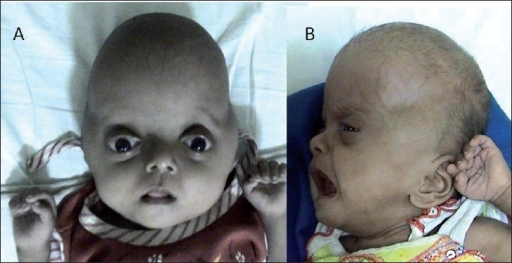Pfeiffer Syndrome Type 3

Pfeiffer syndrome type 3 (PS3) is a severe type of Pfeiffer syndrome (PS; see this term), characterized by bicoronal craniosynostosis, severe associated functional disorders, and hand, foot and elbow abnormalities.
Epidemiology
The exact annual incidence of this form of PS is not known but the incidence of all forms of PS is 1/100,000.
Clinical description
Similar to PS type 2, patients with PS3 manifest severe midfacial underdevelopment. However, unlike PS type 2, patients with PS3 do not have a trilobated skull deformity but present with bicoronal craniosynostosis with turribrachycephaly and associated functional manifestations. Patients have broad medially deviated thumbs and halluces, and variable brachydactyly and syndactyly, as well as ankylosis of the elbow or knee. Choanal stenosis or atresia and laryngotracheal abnormalities are common, often with congenital airway compromise. Complications such as hydrocephalus and seizures are found. All patients have extreme proptosis, often causing exposure keratopathy. Some have amblyopia or optic atrophy causing severe visual impairment, as well as ptosis, strabismus, iris coloboma, refractive errors and cataracts. Developmental and intellectual delays are common. Given the severity of the disease manifestations and associated complications, the prognosis of PS3 is poor, with a high risk of early demise, although the potential for long-term survival may be increased by aggressive early treatment. Causes of death primarily involve respiratory and neurological complications.
Etiology
Mutations in the FGFR2 gene (10q25.3-q26) involved in embryonic developmental cell signaling have been found to be causative for PS3.
Genetic counseling
PS follows an autosomal dominant pattern of inheritance but is generally caused by de novo mutations, especially in the severe forms of the syndrome. Genetic counseling should be provided to affected families.